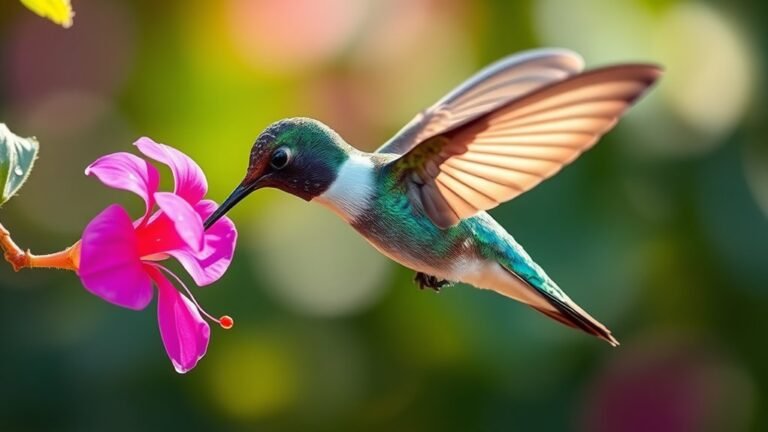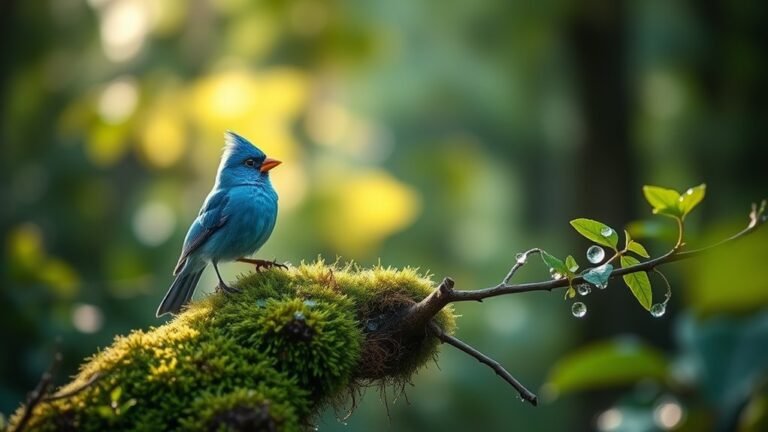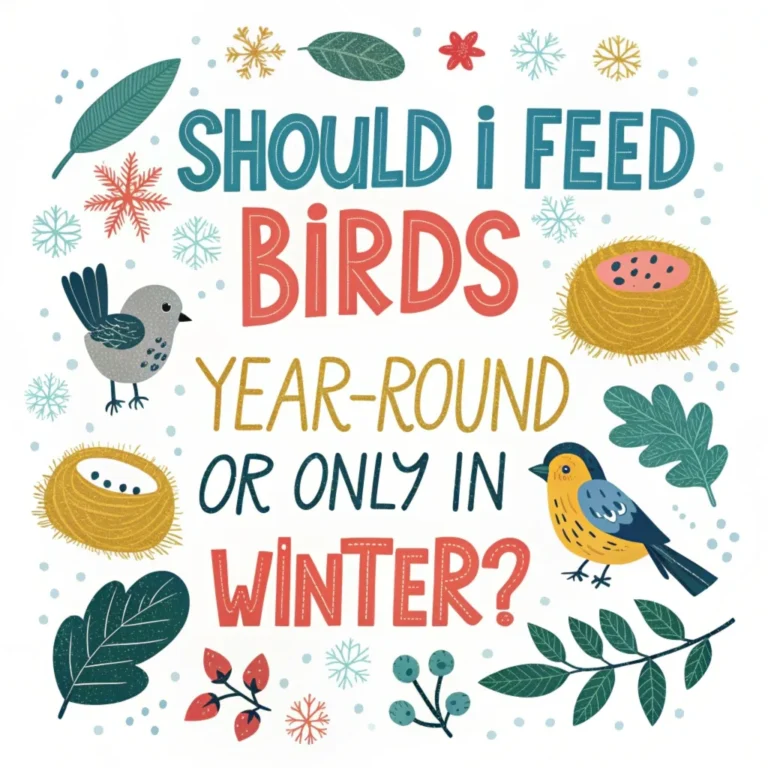Birds That Look Like Meadowlarks: Songbirds of the Fields
In grassland habitats, you may see several songbirds that look like meadowlarks. These birds share similar physical features but have unique traits that fit their specific roles in the ecosystem. Recognizing their differences enhances your appreciation for their beauty and importance. As you observe these birds, remember that each one has its own unique story to share. What makes each bird special?
Key Takeaways
The Western Meadowlark looks similar to the Eastern Meadowlark. Both birds have bright yellow breasts with a black V shape.
Bobolinks have black and white feathers. In open grasslands, their colors can remind one of meadowlarks.
Grasshopper Sparrows blend well into tall grasses. Their subtle colors can resemble larks in their surroundings.
Yellow-headed Blackbirds are mostly black. In wetland areas, their habitat and songs can lead to confusion with meadowlarks.
Other grassland songbirds share similar behaviors and environments with meadowlarks, adding to the variety of sounds and patterns in the fields.
Eastern Meadowlark: The Close Relative
The Eastern Meadowlark is a beautiful bird that closely resembles other meadowlarks. It lives in open grasslands, fields, and agricultural areas, which are perfect for its habitat. You can spot these birds due to their agile movements and cheerful posture.
The Eastern Meadowlark is known for its melodious songs and unique territorial displays. These behaviors help attract mates and protect their territory. They often perform short, fluttering flights and like to perch on fence posts or low shrubs.
Western Meadowlark: A Tale of Two Species
The Western Meadowlark easily confuses bird enthusiasts, as it resembles the Eastern Meadowlark. This colorful songbird lives in open grasslands and fields throughout the western United States.
With its bright yellow breast and a black V shape, the Western Meadowlark is striking and easier to identify once you recognize its features.
This bird primarily eats insects, seeds, and grasses, changing its diet with the seasons. Observing Western Meadowlarks can help you appreciate grassland ecosystems and connect with nature, making it a rewarding experience for bird lovers.
Yellow-headed Blackbird: A Splash of Color
The Yellow-headed Blackbird is easy to spot in wetland habitats like marshes and reed beds. It has a bold yellow head and a solid black body.
These birds prefer areas with plenty of cover and food, such as insects and seeds. They can adapt their diet and often forage near water.
You might see them in small groups, making distinct calls that create a lively sound. Watching these blackbirds enriches your understanding of bird diversity and connects you to the wildlife around you.
Bobolink: The Unique Songster
The Bobolink is a bird known for its striking black and white colors. It primarily lives in open grasslands. This bird is famous for its unique singing behavior, particularly during the breeding season when it performs courtship displays and sings rich melodies.
Bobolinks prefer to nest in tall grasses, which can expose them to habitat loss.
Key features of the Bobolink include:
- Male Bobolinks have black feathers with white wing patches.
- Their songs include various sounds, such as gurgles and whistles.
- They forage for seeds and insects in meadows and uncultivated fields.
- Bobolinks migrate long distances, traveling from North America to South America.
- They've a strong family-oriented nature, which helps bond their social groups.
These characteristics make the Bobolink a fascinating and important species in the grassland ecosystem.
Dickcissel: The Grassland Guardian
The Dickcissel is a striking bird found in grasslands. It features a yellow throat and a bold black bib. This songbird lives in prairies and fields filled with tall grasses and wildflowers. You can often see it perched on fence posts, singing to mark its territory.
Dickcissels are social birds. They usually nest in groups, creating a lively environment. Their songs serve two main purposes: attracting mates and establishing territory.
As important members of the grassland ecosystem, Dickcissels help maintain the health and balance of their habitat. Observing them can provide a delightful experience for anyone who appreciates nature.
Grasshopper Sparrow: The Subtle Mimic
The Grasshopper Sparrow uses effective survival tactics in grassland habitats.
Unlike the colorful Dickcissel, this bird blends into its environment. It prefers open fields with tall grasses, which helps it avoid predators.
The Grasshopper Sparrow communicates through vocal mimicry. It imitates sounds made by grasshoppers and other species, which helps it stay hidden while signaling to others.
Key characteristics include:
- Adaptability to different grassland types
- Preference for dense cover when nesting
- Use of short, raspy calls
- Contribution to ecosystem balance
- Ground foraging for insects and seeds
Understanding the Grasshopper Sparrow's unique methods enhances our appreciation of life in grassy areas.
Common Yellowthroat: The Secretive Singer
The Common Yellowthroat is a charming songbird known for its elusive nature. This small, lively bird prefers dense wetlands and shrubby fields, which provide safety from predators.
You can recognize its unique song—a series of quick, cheerful notes that fill the air around it. These birds often hide among reeds or thick plants, which adds to their secretive character.
The male Common Yellowthroat stands out with its bold black mask and bright yellow throat. This striking appearance, combined with its delightful song, makes it a joy to observe.
Spotting a Common Yellowthroat takes patience, but it's rewarding to see how well it blends into its surroundings, enhancing the beauty and melody of its habitat.
Frequently Asked Questions
What Do Meadowlarks Eat in Their Natural Habitat?
In their natural habitat, meadowlarks have varied diets. They search for food in grasslands and fields. Their main sources of food are insects, seeds, and fruits. Meadowlarks use their sharp beaks to dig into the ground. This helps them find the nutrients they need to thrive. Their feeding habits contribute to the ecosystem by controlling insect populations and spreading seeds.
How Can I Attract Meadowlarks to My Backyard?
To attract meadowlarks, make your backyard inviting. Provide fresh water sources like bird baths. Create natural nesting areas using native grasses and flowers. This will help meadowlarks feel at home and encourage them to visit your yard. Enjoy watching these beautiful songbirds as they sing and explore your space!
What Are the Primary Threats to Meadowlark Populations?
Meadowlark populations face significant threats from habitat destruction and pesticide use. Habitat destruction leads to the loss of their homes and food sources. Pesticides reduce the availability of insects that meadowlarks need for food and can harm their health. To help meadowlarks survive, it is important to protect their habitats and support sustainable farming practices.
Are Meadowlarks Migratory Birds or Permanent Residents?
Meadowlarks have different migration patterns. Some are permanent residents, while others migrate each season. Their farming habits show how weather and food availability affect their movements. This behavior helps them connect with their habitats and create a strong sense of belonging in their ecosystems.
How Do Male Meadowlarks Attract Females During Mating Season?
During mating season, male meadowlarks perform courtship displays and sing unique songs. They show off their bright feathers to attract females. This display not only draws the females in but also helps to strengthen bonds in their territory.

Ava is a bird enthusiast and nature lover who has spent countless hours observing and learning about the fascinating world of birds. With a passion for sharing her knowledge and inspiring others to appreciate the beauty of birds, Ava writes about her experiences and insights on avianadmirer.com.







